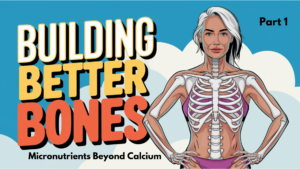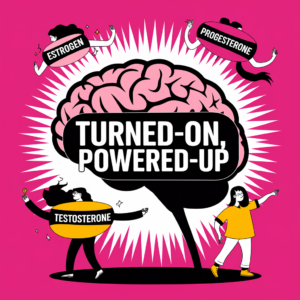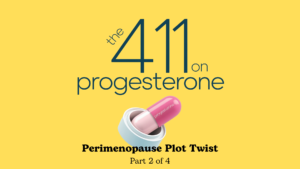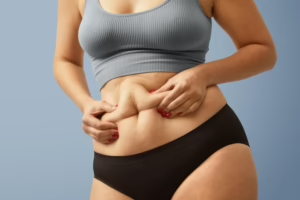Your science-based guide to finally ending hormonal bloating
The Midlife Bloat Epidemic
Ever notice your favorite jeans fit perfectly in the morning but by dinner, you look six months pregnant?
You’re not alone in this frustrating experience. While up to 30% of the general population experiences regular bloating, that number skyrockets to nearly 70% during perimenopause and menopause. Delightful!
This isn’t random—it’s your hormones orchestrating much of this uncomfortable symphony.
The Hormone-Gut Connection Most Doctors Miss
Your hormonal fluctuations aren’t just affecting your mood and energy—they’re fundamentally changing your digestive system:
- Estrogen impacts gut motility. Low estrogen increases inflammation, affecting your gut microbiome and promoting unhealthy digestion. But high estrogen slows down gastric emptying, which can also cause bloat!
- Progesterone can significantly slow digestive transit time (explaining those premenstrual bloating episodes)
- Cortisol imbalance from chronic stress alters your gut microbiome composition and triggers inflammation.
- Thyroid dysfunction (common in midlife) reduces metabolic activity throughout the digestive tract, leading to constipation and bloating.
Understanding this interconnection gives us powerful leverage points for intervention that go beyond the standard “eat more fiber” advice.
10 Science-Backed Strategies to Defeat Hormonal Bloating
1. Optimize Your Eating Window
Your digestive enzymes follow a circadian rhythm, with peak efficiency in the morning and early afternoon. Front-load your calories and consider a 10-12 hour overnight digestive rest period. Research shows this simple timing shift can reduce bloating symptoms by up to 30% in perimenopausal women.
2. Practice Digestive Breathing
Unintentional air swallowing (aerophagia) worsens with stress and rushed eating. Before each meal, take 3-5 deep diaphragmatic breaths to activate your parasympathetic “rest and digest” nervous system. This simple practice has been shown to improve digestive efficiency by up to 20%.
3. Embrace Post-Meal Movement
A 10-15 minute gentle walk after eating can reduce post-meal bloating by up to 50%. This works by stimulating the migrating motor complex (MMC), your gut’s natural cleansing wave. Think of it as giving your digestive tract a gentle, supportive massage.
4. Strategic Hydration
Rather than drinking large amounts with meals (which dilutes digestive enzymes), focus on hydration between meals. Finish your last significant drink about 30 minutes before eating, and limit mealtime liquids to small sips as needed.
5. Support Your Microbiome Daily
The gut-hormone connection works both ways—your microbiome influences estrogen metabolism through what scientists call the “estrobolome.” Regular intake of prebiotic fibers and targeted supplements like tributyrin can nourish the beneficial bacteria that help recirculate estrogen and reduce inflammation. (Shameless plug: we have NewBiome, a well-absorbed form of tributyrin, in our HOP Box supplement stack for precisely this reason!).
6. Correct Your Digestive Posture
The position of your body during and after eating significantly impacts gas trapping and motility. Sit upright while eating (no desk hunching!), and then go for a 10 minute walk after eating – this can keep your blood sugar down and it’s also great for shaking things up in your gut.
7. Identify Your Hormonal Triggers
Your bloating pattern likely follows your hormonal fluctuations. Keep a simple symptom tracker for 30 days, noting where you are in your cycle (or days since your last period if in perimenopause). Look for patterns to anticipate and prepare for vulnerable times. If you’re menopausal and considering hormone replacement therapy, always start with low-ish doses of both estradiol and progesterone because both of these can slow down your gut when you first get started. Symptoms usually improve after 2-3 months at which time you can start increasing the doses as needed.
8. Balance Your Nervous System
The gut-brain axis is particularly sensitive to stress hormones. Incorporate daily stress-management practices like breathwork, meditation, or gentle movement. Even 5-10 minutes daily can significantly reduce cortisol’s inflammatory effects on your digestive tract.
9. Optimize Sleep Position
Sleeping on your left side leverages gravity to improve digestive transit and enhance the natural cleansing waves of your small intestine. This position can reduce morning bloating and improve overnight detoxification pathways.
10. Address B-Vitamin Deficiencies
B vitamins are crucial cofactors for digestive enzyme production and hormonal detoxification pathways. Deficiencies are common in midlife women, especially those taking hormonal medications or experiencing high stress. Consider a high-quality B-complex that includes activated forms like methylfolate and methylcobalamin (aheh… also found in HOP Box).
The Bottom Line
Hormonal bloating isn’t something you just have to accept as you age. By understanding the intricate connection between your hormones and digestive system, you can implement targeted strategies that address the root causes rather than just managing symptoms.
Remember: These changes are most effective when implemented consistently over time. Start with one or two strategies that resonate most with you, then gradually incorporate others as they become habitual.
Your body has an extraordinary capacity to heal and rebalance when given the right support.
Here’s to kicking bloat to the curb during your Queen Phase – get outta here already!
Dr. Amy Killen












